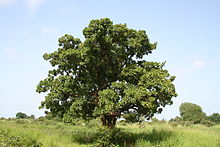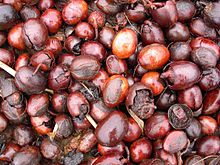Vitellaria paradoxa
| Vitellaria | |
|---|---|
 |
|
| Shea Tree | |
 |
|
| Shea nuts | |
| Scientific classification | |
| Kingdom: | Plantae |
| (unranked): | Angiosperms |
| (unranked): | Eudicots |
| (unranked): | Asterids |
| Order: | Ericales |
| Family: | Sapotaceae |
| Genus: |
Vitellaria C.F.Gaertn. |
| Species: | V. paradoxa |
| Binomial name | |
|
Vitellaria paradoxa C.F.Gaertn. |
|
| Synonyms | |
|
Butyrospermum paradoxa |
|
Butyrospermum paradoxa
Butyrospermum parkii
Vitellaria paradoxa (formerly Butyrospermum parkii), commonly known as shea tree, shi tree, /ˈʃiː/ or /ˈʃiː.ə/, or vitellaria, is a tree of the Sapotaceae family. It is the only species in genus Vitellaria, and is indigenous to Africa. The shea fruit consists of a thin, tart, nutritious pulp that surrounds a relatively large, oil-rich seed from which shea butter is extracted.
The shea tree is a traditional African food plant. It has been claimed to have potential to improve nutrition, boost food supply in the "annual hungry season", foster rural development, and support sustainable landcare.
The tree starts bearing its first fruit when it is 10 to 15 years old; full production is attained when the tree is about 20 to 30 years old. It then produces nuts for up to 200 years.
The fruits resemble large plums and take 4 to 6 months to ripen. The average yield is 15 to 20 kilograms of fresh fruit per tree, with optimum yields up to 45 kilograms. Each kilogram of fruit gives approximately 400 grams of dry seeds.
Shea butter is composed of five principal fatty acids: palmitic, stearic, oleic, linoleic, and arachidic (see Table below). About 85 to 90% of the fatty acid composition is stearic and oleic acids. The relative proportion of these two fatty acids affects shea butter consistency. The stearic acid gives it a solid consistency, while the oleic acid influences how soft or hard the shea butter is, depending on ambient temperature.
The proportions of stearic and oleic acids in the shea kernels and butter differ across the distribution range of the species. Ugandan shea butter has consistently high oleic acid content, and is liquid at warm ambient temperatures. It fractionizes into liquid and solid phases, and is the source of liquid shea oil. The fatty acid proportion of West African shea butter is much more variable than Ugandan shea butter, with an oleic content of 37 to 55%. Variability can be high even locally, and a tree that produces hard butter can grow with one that produces soft butter. Nuts are gathered from a wide area for local production, so shea butter consistency is determined by the average fatty acid profile of the population. Within West Africa, shea butter from the Mossi Plateau region of Burkina Faso has a higher average stearic acid content, and so is usually harder than shea butter from other West African regions.
...
Wikipedia

